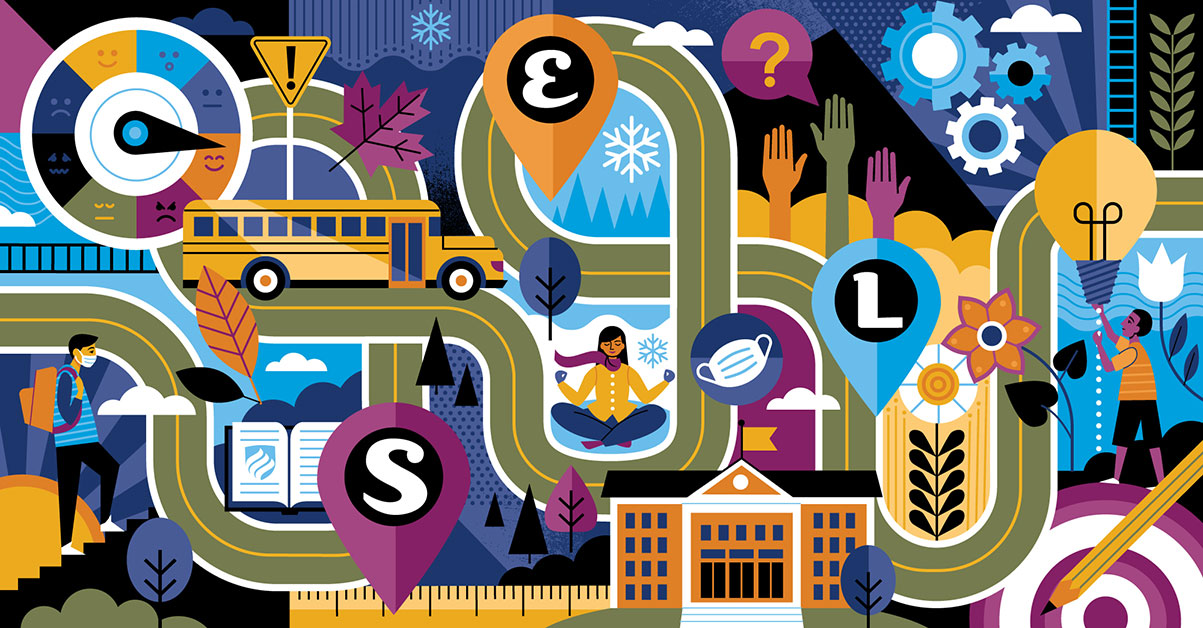How Should Social Emotional Learning Change Post-Pandemic?
CHALKING THE LINE | BY DEBRA MEYER | 7 MIN READ

As a college professor of educators who are entering the profession (pre-service teachers) and teachers returning to earn their master’s degrees and advanced endorsements (in-service teachers), I am always involved in conversations about P–12 social emotional learning (SEL).
What is Social Emotional Learning?
The Collaborative for Academic, Social, and Emotional Learning (CASEL) defines SEL as “the process through which all young people and adults acquire and apply the knowledge, skills, and attitudes to develop healthy identities, manage emotions and achieve personal and collective goals, feel and show empathy for others, establish and maintain supportive relationships, and make responsible and caring decisions.”
SEL has been “talked about” for decades, while “walking the talk” has been more challenging. There are entire websites dedicated to SEL, such as the one at CASEL and Harvard’s EASEL Lab. With pandemic learning interruptions over the past year, educators have a prime opportunity to move social emotional learning alongside physical safety as priority No. 1.
Why Prioritize SEL?
- Academic goals cannot be fully achieved without social emotional knowledge and skills.
- Students, even those who were in physical classrooms for the past year, have not experienced optimal learning environments for developing SEL.
- Given the very different academic and social emotional learning opportunities during the pandemic, returning to face-to-face learning will require more support for social emotional knowledge and skills.
What Might SEL Look Like in the Future?
Let’s apply the CASEL Framework for SEL because it is research-based, well-known, and the foundation for the Illinois SEL Goals, which I focus on in my work with pre-service and in-service teachers.
I think about the CASEL Framework as three interconnected areas:
- Regulating Self
- Interacting with Others
- Decision Making
From preschool through high school, students continue to develop in these three areas. During the COVID-19 pandemic, many hybrid and remote learning difficulties have stemmed from students (as well as families and teachers) not having developed the social emotional skills to adapt to learning in new contexts.
Returning to the brick and mortar classroom will be yet another challenging transition that will encompass next school year and beyond.
Regulating: Self-Awareness and Regulation Skills
All students need to develop self-awareness of what pandemic events and changes in their lives have meant for them. What emotions are they experiencing and what are the most effective ways for them to use these emotions in their learning and interactions with others?
In this way, SEL will need to go beyond the basics and extend to helping students process their return to in-person school, especially as social distancing guidelines change and masks may no longer be needed. A focus in this area suggests a change in the content of learning self-awareness and regulation skills, whether it is through morning messages and circle time for young children or narrative writing and group discussion for older students.
Language arts, health education, and fine arts will be essential in these explorations of: Who am I? Why do I feel this way? How can my emotions help me learn? How can I be happy?
Exploring a sense of self and identity is critical to SEL development, and students need this exploration as their lives move beyond the pandemic.
Interaction: Social Interaction Skills
Alongside personal social emotional awareness, students will need to develop their social skills with others. A year of social distancing, social cancellations, and masking has been critical for public health policy, but most students have not had typical interactions over the last year.
The new school year needs to be approached with much more social interaction that is positive, equitable, and carefully planned and monitored.
Teaching social skills should be a part of every lesson, and teachers must be careful not to return to the status quo.
- All student groupings should be carefully planned and supported to promote respectful and productive interactions (e.g., classroom, playground, hallways, cafeteria, and after-school events). When left to their choices, students do not always benefit from partner or group work because they do not know how to interact effectively. An important lesson from the pandemic was that students who were victims of bullying found relief in the social distancing of classrooms or in remote learning. (See Brittany Wong’s article about how remote learning has decreased some types of bullying and increased other forms.)
- Social skills must be taught and regularly practiced. Classrooms are unique situations and students will need to adjust to these dynamic environments. Teachers will need to plan a coherent SEL curriculum across the academic year to sequence SEL lessons. For example:
- September: Learning everyone’s name and using it in classroom talk.
- October: Demonstrating listening by rephrasing, using hand signals to agree or disagree, and using talk stems.
- November: Taking turns in small groups and participating in equitable ways (not over-talking or under-contributing; learning how to invite others to the conversation and connect contributions).
Hopefully, you can see the possibilities in planning a progression throughout the entire academic year. If you don’t think it is necessary to teach social skills and practice them, just reflect on how well students successfully participated during remote and hybrid learning.
Have fun together. Students (and teachers) need to experience more joy in the classroom. Teachers of all ages should be thinking of ways to add fun into their planning, whether it’s through non-competitive games, visuals, stories, stress-reduction activities or some other means.
Returning to school is going to socially awkward and challenging. Learning will be frustrating at times. Having fun in the classroom with a variety of peers will be critical to students’ social emotional learning.
Decision-Making Skills
Making responsible decisions is the third area of CASEL’s SEL Framework that pulls social emotional learning together. This competency area reflects the ability to make decisions that are ethically and socially responsible.
The pandemic has shined a spotlight on the need for more developed and responsible decision-making—a need that continuously shows up in our classrooms and everyday lives.
As more and more students return to be face-to-face in the classroom, while some remain in remote and hybrid learning environments, teachers need to support students in being able to:
- Think about how our actions might impact others.
- Respond effectively when there are unintended consequences of our actions.
- Be curious and initiate new experiences.
- Make decisions based on data and facts.
Just as teachers need a plan for helping students gain personal and social emotional awareness skills (Regulating and Relating), we will need to have critical conversations and design lessons around responsible decision-making.
These lessons can be designed for all ages and approach essential questions like: Why do people wear masks? What are some ways to have fun and socially distance? How do we know which pieces of information about COVID to trust?
Three Places to Begin
- CASEL has already provided a downloadable roadmap for returning to school with SEL in mind for Spring 2021.
- PBS/WTTW has an excellent series of short videos and resources. Start with the one on responsible decision-making.
- Planbook writes about how to reestablish SEL in returning students.
Start Mastering Social Emotional Learning
Study education at Elmhurst University. Our M.Ed. in Teacher Leadership program is designed to make you a more effective teacher—the kind others turn to for solutions.
Learn more today. Just fill in the form below!
